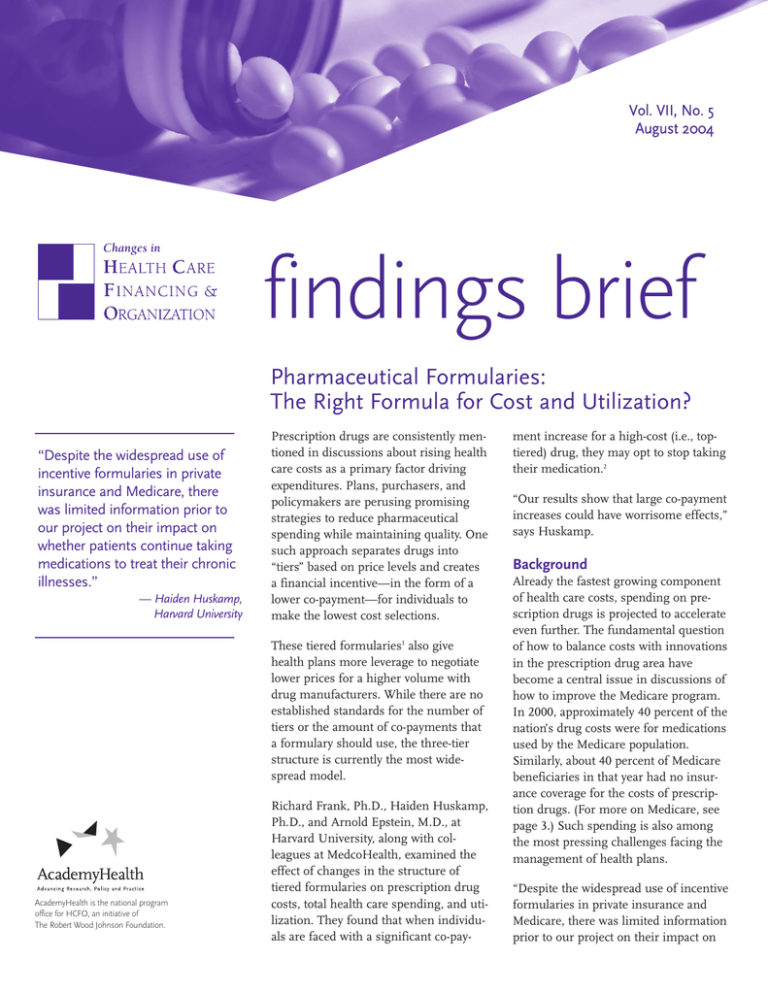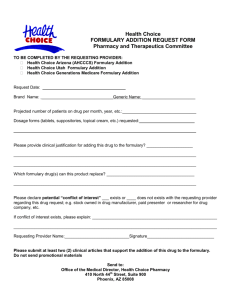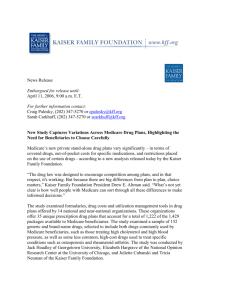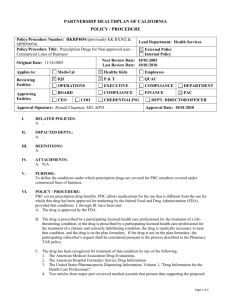findings brief Pharmaceutical Formularies: The Right Formula for Cost and Utilization? September 2002
advertisement

Vol. VII, No. 5 August 2004 September 2002 Vol. 4 Issue 3 Changes in findings brief Pharmaceutical Formularies: The Right Formula for Cost and Utilization? “Despite the widespread use of incentive formularies in private insurance and Medicare, there was limited information prior to our project on their impact on whether patients continue taking medications to treat their chronic illnesses.” — Haiden Huskamp, Harvard University Prescription drugs are consistently mentioned in discussions about rising health care costs as a primary factor driving expenditures. Plans, purchasers, and policymakers are perusing promising strategies to reduce pharmaceutical spending while maintaining quality. One such approach separates drugs into “tiers” based on price levels and creates a financial incentive—in the form of a lower co-payment—for individuals to make the lowest cost selections. These tiered formularies1 also give health plans more leverage to negotiate lower prices for a higher volume with drug manufacturers. While there are no established standards for the number of tiers or the amount of co-payments that a formulary should use, the three-tier structure is currently the most widespread model. AcademyHealth is the national program office for HCFO, an initiative of The Robert Wood Johnson Foundation. Richard Frank, Ph.D., Haiden Huskamp, Ph.D., and Arnold Epstein, M.D., at Harvard University, along with colleagues at MedcoHealth, examined the effect of changes in the structure of tiered formularies on prescription drug costs, total health care spending, and utilization. They found that when individuals are faced with a significant co-pay- ment increase for a high-cost (i.e., toptiered) drug, they may opt to stop taking their medication.2 “Our results show that large co-payment increases could have worrisome effects,” says Huskamp. Background Already the fastest growing component of health care costs, spending on prescription drugs is projected to accelerate even further. The fundamental question of how to balance costs with innovations in the prescription drug area have become a central issue in discussions of how to improve the Medicare program. In 2000, approximately 40 percent of the nation’s drug costs were for medications used by the Medicare population. Similarly, about 40 percent of Medicare beneficiaries in that year had no insurance coverage for the costs of prescription drugs. (For more on Medicare, see page 3.) Such spending is also among the most pressing challenges facing the management of health plans. “Despite the widespread use of incentive formularies in private insurance and Medicare, there was limited information prior to our project on their impact on findings brief — Changes in Health Care Financing & Organization whether patients continue taking medications to treat their chronic illnesses,” says Huskamp. Therefore, the researchers set out to examine: The researchers explored whether the employees who stopped taking a certain drug had switched to an alternate medication to treat their condition, but they found no evidence that this was the case. ◆ The impact of three-tiered formularies on use and spending for prescription drugs and on total health care spending; and ◆ The effect of three-tiered formularies on treatment patterns and continuity for selected tracer conditions affected by formulary changes. Methods The researchers compared non-elderly employees and their dependents from two employers that contract with the same large health plan. The health plan in turn contracts with MedcoHealth, one of the largest pharmacy benefits managers in the country. In 2000, both employers (identified herein as A and B) changed their pharmacy benefits. Employer A moved from a one-tier to a threetier formulary structure and implemented an across-the-board co-payment increase. Employer B changed from a two-tier to a three-tier structure, but increased co-payments only for non-preferred brand-name drugs, which are the highest-cost medications and therefore in the third tier. The researchers also analyzed data on a control group of employees whose benefit package included a two-tier formulary with co-payment levels that remained stable. The drugs assigned to each tier were the same for employers A and B. The study focused on three particular drug classes, which were selected because they are associated with high pharmacy expenditures: 1) ACE inhibitors to treat high blood pressure, congestive heart failure, and diabetes; 2) proton pump inhibitors to treat acid reflux; and 3) statins to treat high cholesterol. This selection of drug classes also allowed the researchers to examine drugs used to treat both acute and chronic illnesses. page 2 The co-payment change for employees working at Employer A was the most dramatic: Prior to 2000, employees had to make a $7 co-payment for all generic and brand-name drugs. Following the formulary structure change, copayments were tiered at $8 for generics, $15 for preferred brands, and $30 for non-preferred brands. For Employer B, the co-payments of $6 and $12 for generics and preferred brands, respectively, remained unchanged, but a third tier was added with a co-payment of $24 for non-preferred brands. Employees in the control group did not experience any change in their two-tier formulary structure. The researchers examined eligibility files and pharmacy claims data, and did a descriptive analysis to explore the extent to which employees switched drugs or stopped taking a particular drug following the formulary change. They also conducted multivariate analyses to assess utilization and spending patterns. Results Utilization The most dramatic changes were seen among Employer A employees. The formulary change resulted in noticeable switching or stoppage, among the drug classes examined, by the employees who had been using thirdtier brand-name drugs. These changes were not replicated among Employee B employees. Among that group (whose formulary was modified from a two- to three-tier structure), those who used third-tier brand-name drugs prior to the formulary change were more likely to switch tiers than controls, but were not more likely to discontinue their medication entirely, as Employer A enrollees were. The researchers explored whether the employees who stopped taking a certain drug had switched to an alternate medication to treat their condition (e.g., from an ACE inhibitor to a beta blocker), but they found no evidence that this was the case. findings brief — Changes in Health Care Financing & Organization Spending Among Employer A employees, there was a negligible change in total drug class spending overall following the formulary adjustment. However, there was a significant shift in who bore the financial burden for the medications. The health plan saw a reduction in its expenditures, while the employees experienced a significant increase in their spending relative to the control group. By contrast, under Employer B’s new formulary structure, monthly plan spending and employee spending changed only slightly compared with controls. “I was surprised that switching rates were not higher, that medication discontinuation was as high as we found it to be, and that so much of the cost savings to plans came from a shift of the burden to enrollees,” says Frank. Study Limitations The investigators acknowledge that their study had some limitations. For example, the researchers did not adjust the results to account for drug manufacturer rebates. Thus, the effect of formulary changes on plan spending and total spending may be underestimated. In addition, the findings may not be entirely generalizable given the many potential differences among employers, insurers, and employees. Implications for Medicare Law The recently passed Medicare Prescription Drug Improvement and Modernization Act of 2003 (MMA) incorporates a variety of private sector cost-control mechanisms, including formularies. Plans offering a drug benefit under MMA have the flexibility to implement any one of a variety of formulary structures, as long as they include drugs in each therapeutic class. While the current study examined an under-65 population, the classes of drugs selected for analysis are widely used by Medicare beneficiaries. Accordingly, MMA plans working to develop the most effective formulary structure should consider both the economic and health changes that can occur when beneficiaries are making drug choices. Are Formularies the Solution? The dramatic changes in Employer A’s formulary structure were a catalyst for significant shifts in utilization and spending. Many employees faced with large co-payments elected to switch to lower cost drugs or stop usage entirely. They also absorbed a larger spending burden. Employer B’s more limited change in formulary design produced little change in employees’ drug utilization patterns and spending. The study’s findings suggest that a formulary’s structure greatly influences an individual’s behavior regarding drug therapy. “The different results for the two employers show that the details really matter,” says Huskamp. “The benefit design before the change is made, the magnitude of the co-payment change, and the characteristics of the covered population are all likely to influence the outcomes of three-tier formulary adoption.” For more information, contact Haiden A. Huskamp, Ph.D., at 617.432.0838. About the Author Bonnie Austin is a senior manager with the Changes in Health Care Financing and Organization (HCFO) initiative. She can be reached at 202.292.6700, or bonnie.austin@academyhealth.org. Endnotes 1 “Tiered” or “incentive” formularies refer to formularies that create a financial incentive for individuals to select among levels of pricing for all drugs, thus preserving all pharmaceutical treatment options for a physician and patient while promoting cost savings. Alternatively, a “closed” formulary limits the number of drugs available for coverage in each class. 2 For more details on this study, see Huskamp, H.A. et al. “The Impact of Incentive Formularies on Prescribing Drug Utilization and Spending,” New England Journal of Medicine, Vol. 349, No. 23, December 3, 2003, pp. 2224–32. page 3 1801 K Street, NW Suite 701-L Washington, DC 20006 Nonprofit Organization U.S. Postage PAID Permit No. 3999 Washington, DC





